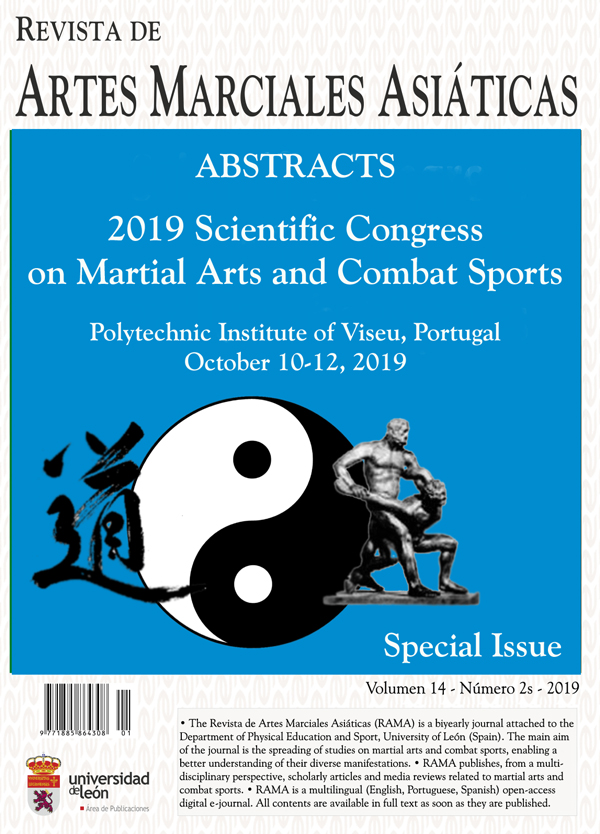Evolution of the temporal structure of world high competition judo combat (2013 a 2017)
DOI:
https://doi.org/10.18002/rama.v14i2s.6022Keywords:
Martial arts, combat sports, judo, performance analysis, combat analysisAgencies:
Universidade Lusófona de Humanidades e Tecnologias (Portugal), Sinse (Portugal), Instituto Superior de Ciências Policiais e Segurança Interna (Portugal), University of Kentucky (United States of America)Abstract
Judo is a sport that is constantly evolving. Rule modifications and changes in tactical strategies have enhanced scoring opportunities and reduced penalties. This study analyzed the evolution of the temporal structure of combat through an assessment of the total match time (TMT), time engaged in combat (CT), time without (TWOG) and with grip (TWG), pause time (PT), the percentage of combat time in tachi-waza and combat in ne-waza, and the frequency of combat/tactical/technical actions/tasks. Data were descriptively analyzed overtime during the 2013, 2014, 2015, and 2017 World Championships and the 2016 Olympic Games. Data from 3,084 male and female matches across weight and gender categories were collapsed and used to compare the TMT, CT, TWOG, TWG, PT, and frequency of tactical actions over time and by competition phase (i.e., qualifiers, quarterfinals, recaps, semi-finals, bronze and finals). There were several temporal changes that occurred due to the rules modifications. The TMT increased by 3.6% over the sampling period for all competition phases. Regarding the duration of combat activities, relative to TMT: 25% was spent in PT (M PT = 8.9 s); 36% (M TWG = 9.6 s) was spent in TWG; 25% (M = 7.3 s) was spent in TWOG; 15% was spent in ne-waza (M = 7.7 s per action). With the changes of the rules in 2017, there was a Golden Point Score increase of 25% in the total number of combat; in relation to the competition phase, there was a 50% increase in the total number of combat activities. There was also a 15% increase in the number of actions in the competition final phase. There was some variation of the time structure of the combat, namely in the total time of the fighting and Golden Point, as a consequence of the change of the Referee rule changes.
Downloads
Métricas alternativas
References
Baudry, S. & Roux, P. (2009). Specific circuit training in young judokas: Effects of rest duration. Research Quaterly for Exercise and Sport, 80, 146-152. doi: https://doi.org/10.1080/02701367.2009.10599548
Blais, L., Trilles, F. & Lacouture, P. (2007). Validation of a specific machine to the strength training of judokas. Journal of Strength and Conditioning Research, 21, 409-412. doi: https://doi.org/10.1519/R-17024.1
Calmet, M., Miarka, B., & Franchini, E. (2010). Modeling of grasps in judo contests. International Journal of Performance Analysis in Sport, 10, 229-240. doi: https://doi.org/10.1080/24748668.2010.11868518
Castanerlas, J.L. & Planas, A. (1997). Estudi del éstructura temporal del combat de judo. Educación Física i Esports, 47, 32-39.
Franchini, E., Miarka, B., Matheus, L. & Del Vecchio, F.B. (2011). Endurance in judogi grip strength tests: comparison between elite and non-elite judo players. Archives of Budo, 7, 1-4.
Franchini, E., Takito, M. & Calmet, M. (2013). European Judo Championships: impact of the new rule changes on points and penalties. International Journal of Performance Analysis in Sport, 13, 474-479. doi: https://doi.org/10.1080/24748668.2013.11868663
Hernández-García, R. & Torres-Luque, G. (2007). Análisis temporal del combate de judo. Revista Internacional de Medicina, Ciencias de la Actividad Física y Deporte, 8, 52-60.
Marcon, G., Franchini, E., Jardim, J.R. & Neto, T.L.B. (2010). Structural analysis of action and time in sports: judo. Journal of Quantitative Analysis in Sports, 6, 1-15. doi: https://doi.org/10.2202/1559-0410.1226
Miarka, B., Julio, U. F., Del Vechio, F. B., Calmet, M., Panissa, V.L. & Franchini, E. (2012). A comparison of time-motion performance between age groups in judo matches. Journal of Sports Sciences, 30(9), 899-905. doi: https://doi.org/10.1080/02640414.2012.679675
Monteiro, L.F. (1995). Estrutura e custo energético do combate de judo. Proceedings of IV Congresso de Educação Física e Ciências do Desporto dos Países de Língua Portuguesa; Coimbra: Universidade de Coimbra, p. 3.
Monteiro, L. & Chambel, L. (2003). Dinâmica do Combate de Judo. Características Masculinos e Femininos. III Conferência Mundial, em Osaka – Japão
Downloads
Published
How to Cite
Issue
Section
License
Copyright (c) 2019 Luis Fernandes Monteiro, Jorge Gonçalves, Luís Chambel, Mark Abel

This work is licensed under a Creative Commons Attribution-NonCommercial-ShareAlike 4.0 International License.
The authors who publish in this journal must agree to the following terms:
- The authors grant on a nonexclusive basis the exploitation rights (reproduction, distribution, public communication and transformation) of the work accepted for publication to the University of León. The authors can establish, on their own, additional agreements for the non-exclusive distribution of the version of the work published in the journal (for example, placing it in an institutional repository or publishing it in a book), always acknowledging the initial publication in this journal.
- This work is licensed under the Creative Commons Attribution-NonCommercial-ShareAlike 4.0 International License. Click to see basic information and the legal text of the license.
- The authors are allowed and encouraged to disseminate electronically pre-print or post-print versions of their work before publication, as this can give rise to productive exchanges, as well as earlier and increased citing of the works published.











